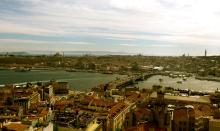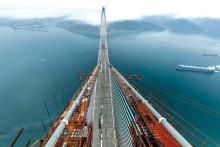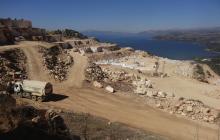
Turkish aggregates demand is looking very promising indeed – despite the country’s turbulent political and economic environment. Guy Woodford reports.
Turkey was caught up in something akin to the eye of a storm in the first half of 2018, with the country’s currency and debt crisis and a high-profile presidential election campaign, culminating in the re-election of Recep Tayyip Erdogan on 24 June, dominating not only national but international headlines.
Since his recent re-election as Turkey’s president less than two months ago, some have argued that Recep Tayyip Erdogan has done little to reduce deep concerns over the state of the Turkish economy by naming his son-in-law, Berat Albayrak, as the country’s new finance minister. Some of the president’s critics have even gone as far as to say that Erdogan’s new role, of executive president, will destroy democracy. The office of prime minister has been abolished, with Erodgan becoming both head of state and head of government. This means he can now directly appoint ministers, many judges and bureaucrats, and one or more vice-presidents.
Despite fears over a renewed period of economic and political turbulence, businesses, including Turkey’s 750-odd aggregates producers, are focusing on the wealth of opportunities created by an estimated €210 billion-plus government and private enterprise spending spree on infrastructure in the decade to 2023.
With limestone making up around 75% of its aggregates reserve, Turkey’s aggregates demand is around 480 million tonnes/year, making the country the third biggest producer in Europe after Germany and Russia. The huge new spending on national infrastructure is likely to see annual aggregates production rise.
Among the new Turkish megaprojects is Canal Istanbul – an €11.1 billion (US$13bn) 45 kilometre shipping route to rival the Suez Canal and take the strain off the Bosphorus, with around 56,000 vessels said to pass yearly through the Istanbul Strait, of which 10,000 are tankers carrying over 130 million tonnes of crude oil. Ground is set to be broken before the end of 2018 on a project which will eventually turn Istanbul’s European side into an island.
The building of Istanbul’s third airport, officially named Istanbul Yenni Havalimani, the Northern Marmara motorway and Canakkale bridge are among other standout elements of Turkey’s giant infrastructure spending programme.
An
Nalbantolu naat is producing a great deal of asphalt mix for the fourth section of the motorway, which will be connected to the Osmangazi Bridge. The company’s portion of the work is a 36km stretch that has been under construction for about three years.
When completed, travel to the new Istanbul Yenni Havalimani airport will be much faster, and traffic relieved in some high-congestion areas.
“It is a profound investment from which the economy, sociocultural structure and tourism will benefit,” said Ali Nalbantolu, chairman of the board of Nalbantolu naat. “The size and the importance of the project are huge. To be part of such an important project is very exciting both for me and the whole company. For more than 20 years, we have improved our roadbuilding techniques and engineering, and with this experience and know-how, we will complete the project in due time and with success.”
Nalbanto lunaat initially utilised a single Ammann ABA 100-340 UniBatch plant on the North Marmara motorway project. The plant was chosen because of its low operational costs and high capacity. The optional additive system, which enabled use of FiberTEK, was another consideration.
So successful was the first ABA 100-340 UniBatch that Nalbantolu naat recently purchased a second to work on the flagship project.
According to research by the Aggregate Producers Association of Turkey (AGÜB), which represents around 50 companies responsible for around 20% of total aggregates production in Turkey, 40% of national aggregates demand comes from Marmara, which includes Istanbul, in the north west of the country; 15% comes from Central Anatolia; 15% from the Mediterranean region; 14% from the Aegean region; 8% from the Black Sea region; 4% from East Anatolia; and 4% from Southeastern Anatolia.
Çalar Tanin, AGÜB’s secretary general, says that Turkish aggregates demand has grown in the last two years – but not at the same rate as before. “Before 2016, the Turkish aggregates sector was growing by 5% [a year]. After 2016 the growth was about 2% [a year]. There are many reasons for this change. The first main reason is the delays in licences issued by the Ministry of Energy and Natural Resources.
“The second was due to political and economic situations’ instability. However, we know that our government primarily supports the Turkish construction sector.
“The biggest building material demand is for concrete and asphalt aggregates. Washing systems with filter presses and cone crushers have become very popular among Turkish aggregates producers.
“Aggregates producers have also shown a big improvement in their consideration of environmental and health and safety issues. We always organise for our members technical visits to producers to see best applications and practices.
“There is now in Turkey a lot more recycling of construction waste materials. The Turkish Standards Institute (TSE) checks through the quality of aggregates very strictly, and Turkish people and aggregates producers have become more conscious about the quality of construction materials.”
Commenting on whether the slump in the value of the Turkish lira impacted on the country’s aggregates sector, Tanin says: “Our economic situation began to slump in 2016. This slump affected our construction sector, with rising exchange rates increasing production costs by 15%. We are lobbying the Turkish government for more support for aggregate producers, and we believe that the excessive loss in the value of the Turkish lira will come to an end.
“The general elections passed successfully. The Turkish government has strengthened and now we are much more hopeful for the future. We expect new projects to begin very soon.”
Tanin, a mining engineer and mining and quarrying health and safety specialist, is also very upbeat about the long-term prospects for the Turkish aggregates industry. “The quality as well as quantity of Turkish aggregates will rise. We believe that production will go up to 700 million tonnes in 2023 – which will be the 100th anniversary year of the Republic of Turkey.”
U.S. global quarrying, mining and construction equipment giant
“Wheeled loaders are used for carrying the marble blocks. For the bigger blocks, 60-tonne block handling loaders are used. In addition, loaders fitted with buckets move the stone waste and the overburden.
“Excavators tend to be used with hammers and can also be fitted with other tools such as rippers to separate the blocks from the face.
“The support provided to keep the machines working is crucial and Cat Borusan has a dedicated team to support its marble quarrying customers. The team, strategically located to provide fast response time, works very closely with the quarries to provide them with quick parts deliveries and technical support, and customers have access to a team of mobile engineers locally based in the regions where marble is extracted.”
Commenting on the use of quarry machine fleet automation and technology in Turkish aggregates production, Dereliolu adds: “From our customers’ perspective, [Cat] Product Link is used to manage equipment utilisation. Product monitoring is commonly used to provide preventative maintenance and address issues before failures occur.
“From a safety perspective, integrated rear vision cameras enhance visibility behind Cat wheeled loaders, with right side cameras attached to Cat excavators.”









